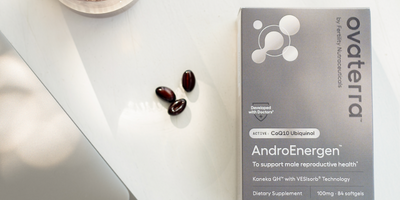Sperm count has been declining for decades. A new meta-analysis found that the decline is global, and the rate of decline has accelerated significantly in the 21st century. In fact, compared to 1973, sperm count had declined by a whopping 62% by 2018. What does this mean for human fertility? Are there anything you can do to protect your - or your partner's - male reproductive health? Let’s start with the study’s findings.
Key findings
- The new study is a follow-up to the same authors’ 2017 paper that reported on the significant decline in sperm health parameters in Europe, North America and Australia/New Zealand between 1973 and 2011.
- In the new study, the authors analyzed 7 years of additional data in 44 new estimates. Countries from South/Central America, Asia and Africa were also included in the new analysis, thanks to the increase in published studies from these areas in recent years.
- Sperm concentration declined by 51.6% from 1973 to 2018 among unselected men; total sperm count declined by 62.3% over the same period.
- The rate of decline accelerated – more than doubled, in fact – after 2000. In the period after 2000, the sperm concentration declined by 2.64% every year, compared to 1.16% annually between 1974 and 2000.
What are sperm concentration and sperm count?
Both sperm concentration and sperm count are important parts of male fertility assessment. Sperm concentration is the number of sperm per 1 ml of ejaculate (semen), while sperm count refers to the total number of sperm found in an entire ejaculate, usually calculated based on sperm concentration and semen volume.
Other important aspect of sperm health include motility (its ability to move), progressive motility (its ability to move straight forward), morphology (its structural health, i.e., what healthy sperm looks like under a microscope) and integrity of its DNA.
What is a normal sperm count?
There's a fairly wide range of what's considered a normal sperm count. Doctors consider sperm concentration of 15 million/ml of ejaculate to over 200 million/ml to be the normal sperm count range. When there are fewer than 15 million/ml or fewer than 39 million in the entire ejaculate, that’s considered low sperm count.
While still considered normal, sperm concentration below 50 million/ml can be a concern when it comes to a man's chances of establishing a pregnancy.
Why are sperm count and concentration important?
Sperm count and concentration are important indicators of a man’s reproductive health. Studies have found that men with a healthy number of sperm in each ejaculate have a better chance of getting their partners pregnant, compared to men with lower sperm count.
This makes intuitive sense – once the sperm enters the female reproductive tract, they swim toward the ovulated egg for a chance to fertilize it. The more swimmers there are, the better the chance that one of them will find and fertilize the egg.
Sperm count decline and chances of pregnancy
As the study authors point out, however, the relationship between sperm count and chances of pregnancy isn’t linear. Over the rough threshold of 40-50 million/ml, having a higher sperm concentration doesn’t necessarily translate to higher fertility. Below that threshold, however, studies have found that the likelihood of a pregnancy starts declining rapidly.
In the early 70s, the mean sperm concentration was 104 million/ml, which is well above the 40-50 million/ml threshold. However, by mid-2010s, the mean sperm concentration had dropped to 49 million/ml, putting a significant number of men across the globe under this threshold – and potentially at risk of fertility struggles.
What can you do to protect sperm health?
The study doesn’t go into what may be causing the significant, continued decline in sperm count. However, we do know a number of factors negatively affect different aspects of sperm health, including sperm count.
Genetics and advancing age play a role. However, other sperm health factors are within your control. Many of these lifestyle factors impact sperm health during spermatogenesis – the all-important process where immature sperm develop to full maturity. Many also involve oxidative stress, which can damage sperm cells and their DNA.
Here are some steps you can take to protect the health of your sperm:
- Quit smoking and other harmful activities: Science is conclusive on the detrimental effects of smoking on sperm health. Excessive consumption of alcohol and caffeine, as well as recreational drug use, including marijuana, has also been suggested as potential causes of low sperm count and poor quality sperm, so it’s a good idea to stay away from these while you are trying for a pregnancy.
- Maintain a healthy weight: Being overweight and obese has been associated with lower sperm count and male fertility in general. Scientists have postulated several ways having extra fat tissue can affect male fertility, including the reduction in testosterone levels and increased oxidative stress.
- Manage stress: Time and time again, high stress levels have been linked to poor sperm health, including low sperm concentration. Chronic high stress can alter how the hypothalamus-pituitary-adrenal axis (HPA) works, which can reduce testosterone levels. It’s not practical to completely eliminate stress, so find healthy ways to cope with stress to support your sperm health.
- Healthy diet: Eating healthy is a major part of reproductive health. For sperm health, Vitamin D and antioxidants like Vitamin C, Vitamin E and CoQ10 seem to be particularly important. Studies have suggested that the Mediterranean diet is one of the best “fertility diets” for both men and women. Rather than looking for a single magic food item that may boost sperm count, focus on the overall pattern of eating.
- Get plenty of quality sleep: Sleep is another factor that impacts the HPA axis. In both sexes, sleep disruptions have been shown to negatively impact fertility, so try to get plenty of good-quality sleep each night. Testing your sleep with at-home sleep tests like Wesper can give you a good idea of your sleep health and guidance on how to sleep better, informed by how you actually sleep. Check out this video for how to sleep better for fertility.
- Avoid too much soy and endocrine disruptors: Food-derived estrogen, particularly from soy, and endocrine disruptors like BPA and "forever chemicals" (PFAS) that mimic estrogen in the body can reduce sperm count through hormonal imbalance and low testosterone levels.
- Reduce exposure to toxins: Heavy metals, air pollution and other environmental toxins can negatively impact sperm count and other parameters of sperm health.
Scientists don't know why sperm count has been declining, and why the drop has accelerated in the last 20+ years. Likely, it's a combination of factors, including environmental factors beyond our individual control, with disparate impacts on disadvantaged communities.
However, if you are on a fertility journey or plan to start soon, it's a good idea to do what you can to protect and nurture your sperm - so that you can maximize your chances of conception and, eventually, a healthy baby.
Consult your doctor sooner rather than later, if you feel like you are running into a roadblock. And please reach out if we can answer any questions about sperm count and reproductive health. We are with you.
Study vitals
- Title: Temporal trends in sperm count: A systematic review and meta-regression analysis of samples collected globally in the 20th and 21st centuries
- Authors: Levine H, et al.
- Publication date: 11/15/2022
- Journal: Human Reproduction Update
- Study type: Meta-Analysis












